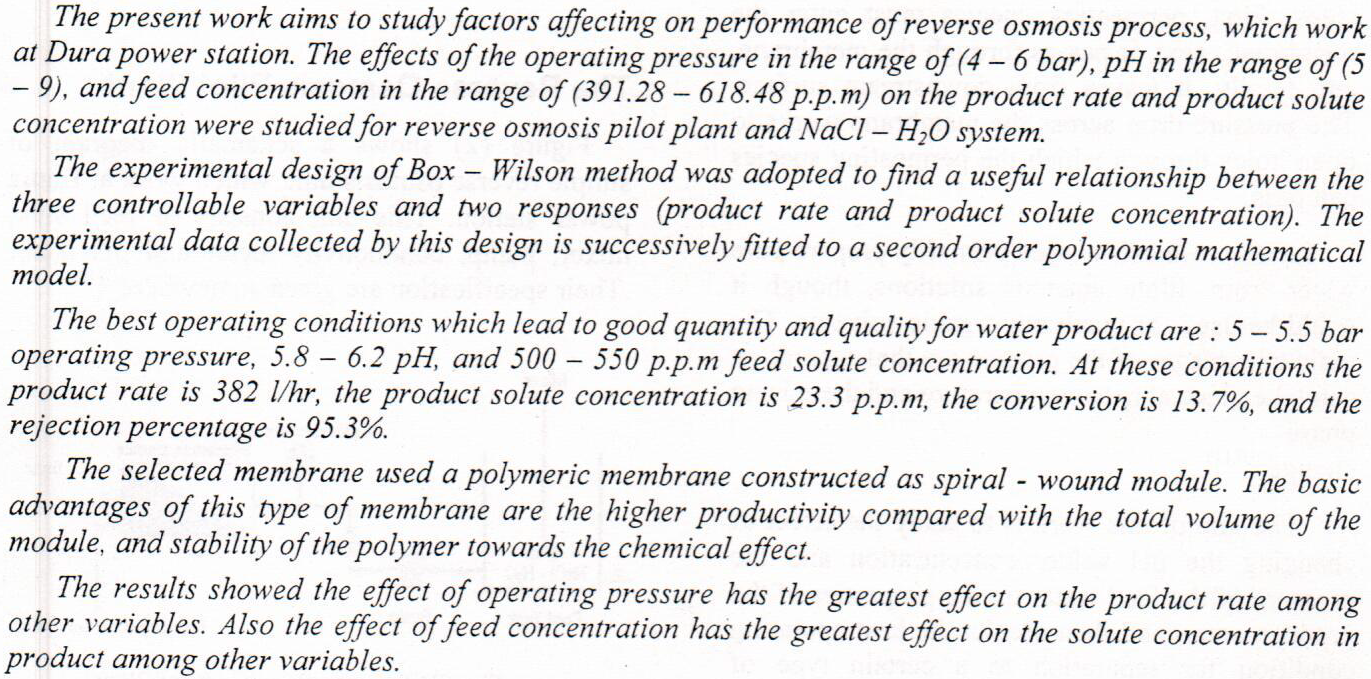
This study is concerned with the evaluation of the effect of Euphrates River water quality in Al-Samawa region during
the period 1984-2003 on efficiency and reliability of reverse osmosis desalination systems by calculating the calcium
sulfate scaling index depending on the following indicators: - TDS, Ca+2, Mg+2, Na+1, Cl-1, So4-2, HCO3-1. It was
found from data analysis that this index for these units is greater than permissible limit. Also, the fitted relationship
between this index and TDS is logarithmic, i.e. this index varies more rapidly than TDS, and consequently it is more
representative to the water quality than TDS.
The aim of this work is to study reverse osmosis characteristics for copper sulfate hexahydrate (CuSO4.6H2O), nickel sulfate hexahydrate (NiSO4.6H2O) and zinc sulfate hexahydrate (ZnSO4.6H2O) removal from aqueous solution which discharge from some Iraqi factories such as Alnasser Company for mechanical industries. The mode of operation of reverse osmosis was permeate is removed and the concentrate of metals solution is recycled back to the feed vessel. Spiral-wound membrane is thin film composite membrane (TFC) was used to conduct this study on reverse osmosis. The variables studied are metals concentrations (50 – 150 ppm) and time (15 – 90 min). It was found that increasing the time results in an increase in concentration of metal in p
... Show MoreThis study was aimed to measure marketing efficiency and study important factors affecting , using TOBIT qualitative response model for wheat crop in Salahalddin province. Results revealed that independent factors such as (marketing type, crops duration in the field, average marketing cost, distance between farm and marketing center, and average productivity) had an impact on wheat marketing efficiency. This impact varied in size and direction due to value of parameters. Values of marketing efficiency fluctuated within cities and towns in the province. The average value on the province level was 76.75%. This study was recommended developing marketing infrastructures which is essential to efficiency increases. In addition, it is impo
... Show More (6)
(6)
 (2)
(2)
The research aims to apply the novel forward osmosis (FO) process to recover pure water
from contaminated water. Phenol was used as organic substance in the feed solution, while sodium
chloride salt was used as draw solution. Membranes used in the FO process is the cellulose
triacetate (CTA) and polyamide (thin film composite (TFC)) membrane. Reverse osmosis process
was used to treatment the draw solution, the exterior from the forward osmosis process. In the FO
process the active layer of the membrane faces the feed solution and the porous support layer faces
the draw solution and this will show the effect of dilutive internal concentration polarization and
concentrative external concentration polarization.
In th
 (4)
(4)
In this study, aromatic polyamide reverse osmosis membranes were used to remove zinc ions from electroplating wastewater. Influence of different operating conditions such as time, zinc concentration and pressure on reverse osmosis process efficiency was studied. The experimental results showed, concentration of zinc in permeate increase with increases of time from 0 to 70 min, and flux of water through membrane decline with time. While, the concentrations of zinc in permeate increase with the increase in feed zinc concentration (10–300 mg/l), flux decrease with the increment of feed concentration. The raise of pressure from 1 to 4 bar, the zinc concentration decreases and the flux increase. The highest recovery percentage was fou
... Show MoreIn this study, aromatic polyamide reverse osmosis membranes were used to remove zinc ions from electroplating wastewater. Influence of different operating conditions such as time, zinc concentration and pressure on reverse osmosis process efficiency was studied. The experimental results showed, concentration of zinc in permeate increase with increases of time from 0 to 70 min, and flux of water through membrane decline with time. While, the concentrations of zinc in permeate increase with the increase in feed zinc concentration (10–300 mg/l), flux decrease with the increment of feed concentration. The raise of pressure from 1 to 4 bar, the zinc concentration decreases and the flux increase. The highest recovery percentage was found is 54.
... Show MoreThermal conductivity of compacted bentonite is one of the most important properties where this type of clay is proposed for use as a buffer material. In this study, Lee's disc method was used to measure the thermal conductivity of compacted bentonite specimens. The experimental results have been analyzed to observe the three major factors affecting the thermal conductivity of bentonite buffer material. While the clay density reaches to a target value, the measurement is taken to evaluate the thermal conductivity. By repeating this procedure, a relationship between clay dry density and thermal conductivity has been established in specimens after adjusting the water contents of the bentonite by placing its specimens in a drying oven for diffe
... Show More (1)
(1)



